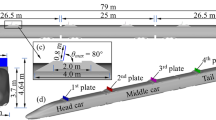Abstract
When aerodynamic braking works, the braking wings can change the flow field around the train, which may impact on the comfort and safety. Based on a sliding mesh, the pressure wave and flow field around high-speed trains with aerodynamic braking are analyzed. By comparing three typical intersection situations, the pressure wave of a high-speed train during braking (with or without aerodynamic braking) is studied. The analyses indicate that the pressure wave around the high-speed train body will change while using the aerodynamic braking, causing several pressure pulses on the surface of crossing high-speed trains. The distances between the pressure pulses are equal to the longitudinal distances of the brake wings, but the magnitudes of the fluctuations are less than those induced by the head of crossing trains. During the crossing, a train without aerodynamic braking will not impact the crossing train.
Similar content being viewed by others
References
Fei, W.W., Tian, C., Wu, M.L., 2009. Research on Brake Type of High-Speed Train Based on Air Dynamics. The National Industrial Aerodynamic Academic Conference, Changsha, China, p.238–244 (in Chinese).
Lu, G.D., 2006. The aerodynamics points of high speed trains. Rolling Stock, 44(6):1–3, 44–45 (in Chinese).
Qi, Z.D., 2010. Aerodynamics Research on High-Speed Train Passing Each Other. MS Thesis, Southwest Jiaotong University, Chengdu, China (in Chinese).
Qiu, Y.Z., Xu, Y.G., Wang, Y.L., 2005. An Aerodynamic Model of Bottom Structures of High-Speed Trains. Fluent Chinese User Conference, p.151–155 (in Chinese).
Raghunathan, R.S., Kim, H.D., Setoguchi, T., 2002. Aerodynamics of high speed railway train. Progress in Aerospace Sciences, 38(6–7):469–514. [doi:10.1016/S0376-0421(02)00029-5]
Tian, H.Q., 2006. Study evolvement of train aerodynamics in China. Journal of Traffic and Transportation Engineering, 6(1):1–9 (in Chinese).
Tian, H.Q., 2007. Train Aerodynamics. China Railway Press, Beijing, China (in Chinese).
Wang, F.J., 2004. Computational Fluid Dynamics (CFD) Software Analysis Principle and Application. Tsinghua University Press, Beijing, China, p.67–70 (in Chinese).
Author information
Authors and Affiliations
Corresponding author
Additional information
Project (No. 2009BAG12A05-13) supported by the National Key Technology R&D Program of China
Rights and permissions
About this article
Cite this article
Wu, Ml., Zhu, Yy., Tian, C. et al. Influence of aerodynamic braking on the pressure wave of a crossing high-speed train. J. Zhejiang Univ. Sci. A 12, 979–984 (2011). https://doi.org/10.1631/jzus.A11GT011
Received:
Accepted:
Published:
Issue Date:
DOI: https://doi.org/10.1631/jzus.A11GT011




